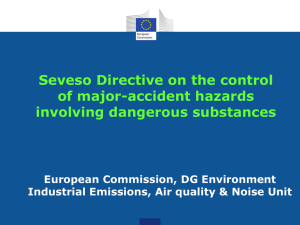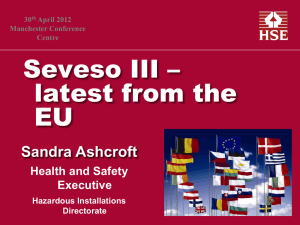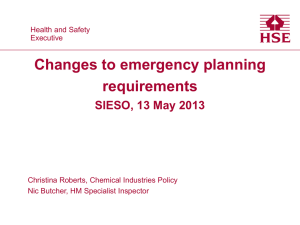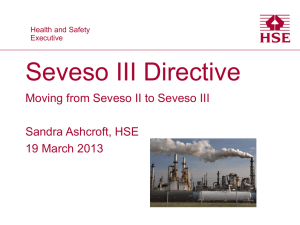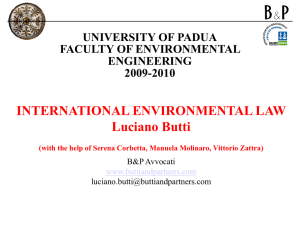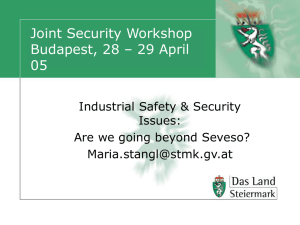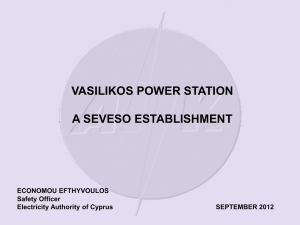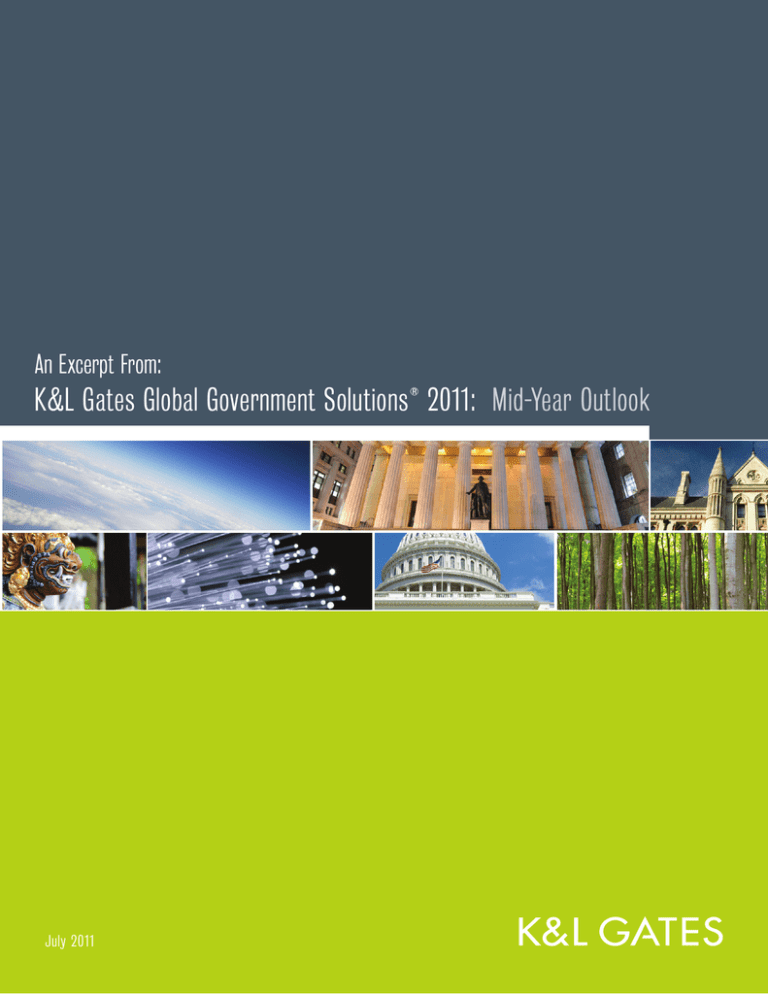
An Excerpt From:
K&L Gates Global Government Solutions ® 2011: Mid-Year Outlook
July 2011
Energy and Environment
Proposed Changes to the EU Seveso II Directive
The European Commission has proposed changes to the European Union’s (“EU”)
“Seveso II” Directive, which regulates hazardous materials. These changes would
have the effect of dramatically expanding the scope of the Directive and thus the
responsibilities covered establishments. The Seveso accident happened in 1976
at a chemical plant in Seveso, Italy, manufacturing pesticides and herbicides.
A dense vapor cloud containing dioxin, a poisonous and carcinogenic byproduct of an uncontrolled reaction, was released from a reactor. Although no
immediate fatalities were reported, kilogram quantities of a substance lethal to
man even in microgram doses were widely dispersed, which resulted in extensive
contamination of land and vegetation, mass evacuation and as many as 2,000
cases of dioxin poisoning.
dangerous substances are present in
greater quantities than those which
trigger this obligation is required to draw
up (and review and keep updated) a
safety report and internal emergency
plans and to provide the relevant national
authority with the necessary information
to enable it to draw up external
emergency plans. Finally, operators of
such establishments must provide certain
information to the authorities following a
major accident.
Seveso II applies to all establishments
where specified quantities of dangerous
substances are present as a raw
material, product, by-product, residue,
or intermediate. It also applies where
the presence of dangerous substances is
anticipated and where it is reasonable to
suppose that dangerous substances may
be generated in the event of accident.
Seveso II also provides for inspections
by national authorities and imposes a
number of other obligations on national
authorities. Member States may, and
in some cases must, penalize failure to
comply with certain of its requirements by
prohibiting any use of the establishment
concerned (which could involve shutting
the plant).
Once Seveso II applies, numerous
potentially onerous obligations are
triggered. Seveso II requires operators
of establishments within its scope to take
all measures necessary to prevent major
accidents and to limit their consequences
for humans and the environment. More
specifically, the operator of such an
establishment must notify the relevant
national authority with prescribed
information about the operator, the
establishment, and the dangerous
substances concerned and must draw
up, document, and implement a majoraccident prevention policy. In addition,
the operator of an establishment where
Application of Seveso II is triggered
by the presence of a given quantity
of a “dangerous substance” at an
establishment. For this purpose,
“dangerous substance” means a
substance or mixture which is expressly
listed in Seveso II or which (essentially)
has been classified as a dangerous
substance or mixture in accordance with
existing EU legislation on classification.
In response, the EU adopted its first
Seveso Directive (“Seveso I”) in 1982.
Seveso I required EU Member States to
ensure that certain manufacturers took
the measures necessary to prevent major
accidents and to limit their consequences
for humans and the environment. In the
light of accidents at the Union Carbide
plant in Bhopal, India in 1984 (where a
factory leak of methyl isocyanate caused
more than 2,500 deaths) and at the
Sandoz warehouse in Basel, Switzerland
in 1986 (where contaminated fire-fighting
water caused massive pollution of the
Rhine and the death of half a million fish),
Seveso I was amended so as to broaden
its scope, in particular to include the
storage of dangerous substances.
Seveso II, which repealed and replaced
Seveso I in 1996, imposed obligations
directly on industry as well as on Member
States. In addition, the scope was
widened again and new requirements
were added.
Under that legislation it is possible for
a substance or mixture to be classified
as dangerous solely because it contains
a constituent which is itself classified,
even though the principal substance or
The European Commission has proposed changes to the European Union “Seveso II” Directive,
which regulates hazardous materials.
32
K&L Gates Global Government Solutions ® 2011 Mid-Year Outlook
Energy and Environment
In December 2010 the European
Commission published a Proposal for a
Seveso III Directive which would repeal
and replace Seveso II with effect from
June 1, 2015 (to coincide with the full
implementation of the CLP Regulation).
The principal change would be that
Seveso III would reflect the new system
for the classification of hazardous
substances and mixtures laid down by
the CLP Regulation.
mixture has not itself been independently
shown to be dangerous. This may result
in an anomalous situation which can be
illustrated by assuming that Substance A
is classified as a dangerous substance
for which the Seveso II quantity threshold
is 100 tonnes and that Substance B
contains 1 percent Substance A as
an impurity and is itself classified as a
result. Substance B will therefore be a
“dangerous substance” within the scope
of Seveso II. A facility will therefore be
subject to Seveso II if 100 tonnes of
Substance B are present even though only
one tonne of Substance A is present. In
contrast, a facility at which 99 tonnes of
Substance A as such are present will not
be subject to Seveso II.
For various reasons, this anomaly has
not previously given rise to significant
problems in practice. However, recent
and continuing changes to the EU
legislation on classification mean that it
is likely to be more of a problem in the
future if the opportunity is not taken to
rectify it. That legislation is currently being
phased out and replaced by the new EU
Regulation on Classification, Labelling and
Packaging of Substances and Mixtures
(“CLP Regulation”). This Regulation
implements the UN Globally Harmonised
System of classification and labelling of
chemicals, which differs in some respects
from the current EU legislation.
Changes to the procedure for
classification flowing from the CLP
Regulation will mean that many more
substances will be classified because
of an impurity and many more mixtures
will be classified because of a minor
constituent. This greatly increases the
risk that an establishment may become
subject to Seveso III and its attendant
obligations solely because a very small
amount of a classified substance is
contained in a compound substance or
a mixture present at the establishment,
while another establishment containing
a much greater quantity of the classified
substance remains outside the scope of
Seveso III. Although Seveso III contains
a derogation that might assist, this
depends on the substance concerned
being on a list compiled by the European
Commission; it does not address the root
of the anomaly.
The proposed Seveso III Directive is
currently proceeding through the EU
legislative process. Some industry sectors
are hoping to persuade the legislature
to make amendments to remove the
anomaly. It remains to be seen whether
these efforts will bear fruit.
Vanessa C. Edwards (London)
vanessa.edwards@klgates.com
Raminta Dereskeviciute (London)
raminta.dereskeviciute@klgates.com
K&L Gates Global Government Solutions ® 2011 Mid-Year Outlook
33
Anchorage Austin Beijing Berlin Boston Brussels Charlotte Chicago Dallas Doha Dubai Fort Worth Frankfurt Harrisburg Hong Kong
London Los Angeles Miami Moscow Newark New York Orange County Palo Alto Paris Pittsburgh Portland Raleigh Research Triangle Park
San Diego San Francisco Seattle Shanghai Singapore Spokane/Coeur d’Alene Taipei Tokyo Warsaw Washington, D.C.
K&L Gates includes lawyers practicing out of 38 offices located in North America, Europe, Asia and the Middle
East, and represents numerous GLOBAL 500, FORTUNE 100, and FTSE 100 corporations, in addition to growth
and middle market companies, entrepreneurs, capital market participants and public sector entities. For more
information about K&L Gates or its locations and registrations, visit www.klgates.com.
This publication is for informational purposes and does not contain or convey legal advice. The information herein should not be used or relied upon in regard to
any particular facts or circumstances without first consulting a lawyer.
©2011 K&L Gates LLP. All Rights Reserved.

